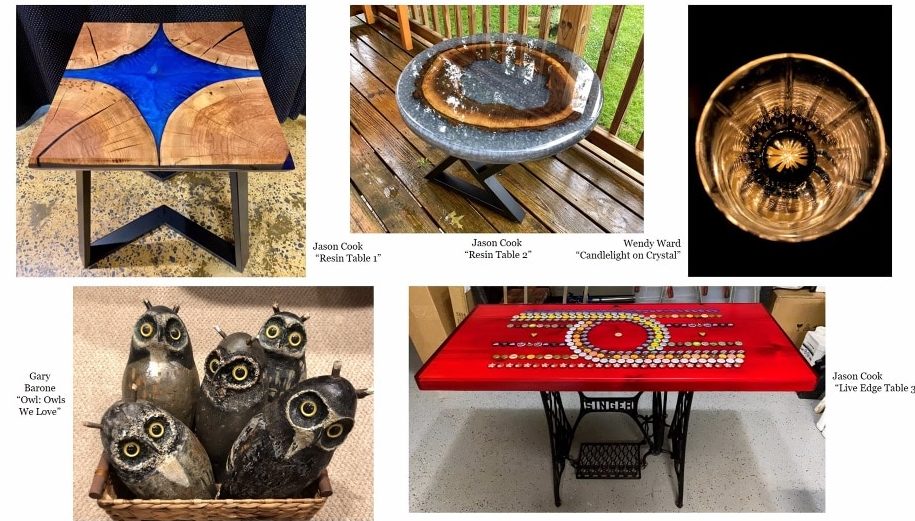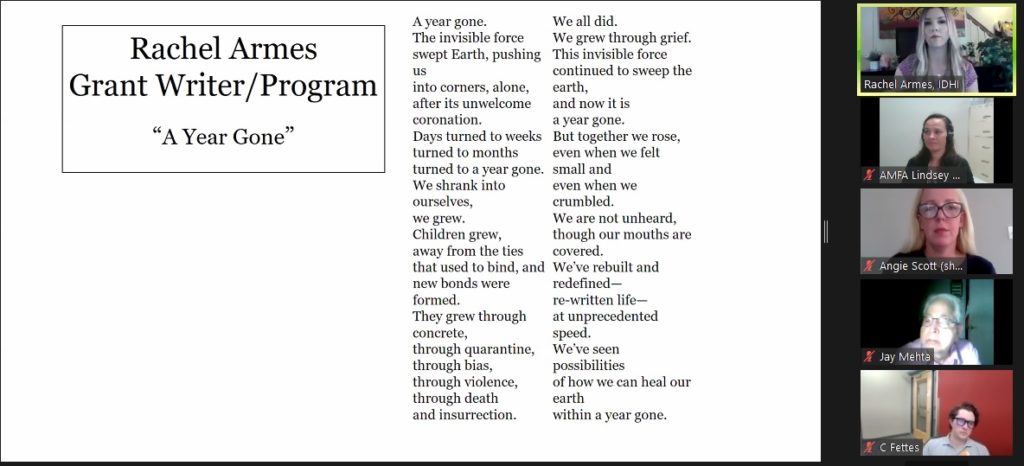Art from the Heart Virtual Exhibit Spotlights UAMS Artists
| The COVID-19 pandemic has sparked introspection and creative expression in many artists who work and study at UAMS.
The pandemic and social-distancing measures meant the third annual Art from the Heart exhibition, held April 15, was virtual.
(View the artists and their artwork).
“How does it impact our lives to take time to look at art? Is that different now than last year or two years ago?” said Angie Scott, M.D., Ph.D., assistant professor in the College of Medicine Department of Medical Humanities and Bioethics. “For those of you who are artists, I would love to hear if your experience in creating this year was different than it has been in the past. It’s always important to make space in our lives for art, but this year it may be truer than ever.”

Aparna Das, right, was one of several artists whose work was featured in Art from the Heart. Her paintings here were in the Orienting group of the exhibition.
Sponsored by the UAMS Office of Interprofessional Education, Wendy Ward, Ph.D., director of interprofessional faculty development and associate provost for faculty in the Division of Academic Affairs, helped organize the first Art from the Heart exhibit in 2019, and she delivered the introductory remarks at this year’s virtual exhibit on Zoom.
Art from the Heart partners and supporters also included the Arkansas Museum of Fine Arts (formerly the Arkansas Art Center); Lindsey Knight, the museum’s education coordinator; Natalie Cannady, M.Ed., UAMS chief wellness officer; Eric Messias, M.D.; Angie Scott and D. Micah Hester, Ph.D., chair of the Department of Medical Humanities and Bioethics in the College of Medicine.
The art displayed was grouped into six thematic categories: Orienting, In the Round, Finding Our Place, Nature Observed, the Healing Earth and Hope in the Dark. Attendees and artists took part in roundtable discussions as each group was presented and during a wrap-up session at the end.
During the presentation of the Orienting group, Rachel Armes, program manager in the UAMS Institute for Digital Health & Innovation, read her poem, “A Year Gone.” Aparna Das, M.D., a resident physician in the UAMS Psychiatric Research Institute had two submissions in the category: the paintings “Looking Out the Window” and “Spring.”
While she said “Spring” was a visual statement about the conflict in the Indian state of Kashmir, some of her creative motivation was spurred by the pandemic.
“My family was so far away, and I was so worried this last year watching the news,” Das said. “I explored all the mediums there are. I ended up drawing or painting every night, and it helped me get through something so personal.”
Christopher Fettes read one of his poems “Campus Duet.” He found relief from similar pressures through writing daily.
“I committed at the beginning of the last year to writing a poem every day and focusing on a new year and decade with 2020,” said Fettes. “Writing daily created a record for the year, and I can look back on that and trace how I went through it day by day. I would encourage people to do something consciously and daily to capture these moments in a creative way.”

Three-dimensional works of art also were on display in the In the Round group in the Art from the Heart exhibition.
Fettes is a program coordinator in the Department of Environmental and Occupational Health and instructor of the College of Public Health Writing Workshop, both in the UAMS Fay W. Boozman College of Public Health.
Although the pandemic was an influence behind much of the art in the exhibit, it wasn’t an element in all of them.
For the group called In the Round, Jason Cook, a medical buyer in the UAMS Office of Procurement Services, contributed some colorful tables he had made using woods and resins.
“The resin tables have been a labor of love,” Cook said. “This type of project takes a long time to complete. There are multiple stages involved. For me, this process is all about reconstruction and deconstruction.”
A research assistant in the UAMS College of Medicine Department of Microbiology and Immunology, Priyandi Malaviarachchi’s drawings and sketches of plants and birds were taken from the flora and fauna in her own garden.
The Hope in the Dark group included several photographs by Wendy Ward of candles which were partly melted and lit.

Poem readings like this one by Rachel Armes also were a major part of the exhibition.
“There is a sense of time with these,” said Edgar Meyer, Ph.D., assistant professor in the UAMS College of Medicine Department of Neurobiology & Developmental Sciences. “A candle doesn’t typically last very long. Eventually, the candle cannot be used. Knowing how ephemeral things are should draw us into being with them and maximizing our time with them.”
